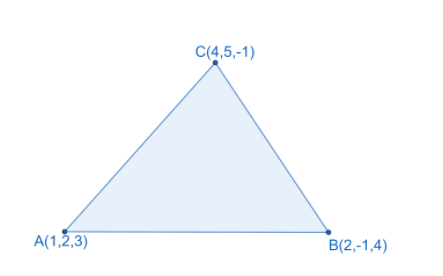Question
Question: If the vectors \(A\left( 1,2,3 \right)\), \(B\left( 2,-1,4 \right)\) and \(C\left( 4,5,-1 \right)\) ...
If the vectors A(1,2,3), B(2,−1,4) and C(4,5,−1) are the vertices of the triangle ABC, then find the area of the triangle ABC.
Solution
We start solving the problem by finding the vector of the sides of the triangle AB and AC. Once we find the vectors, we find the cross product of the sides which we calculated and take the magnitude of it. After finding the magnitude, we divide it with two to get the area of the triangle.
Complete step-by-step answer :
According to the problem, we have a triangle with vertices A(1,2,3), B(2,−1,4) and C(4,5,−1). We need to find the area of the triangle with the given vertices.
Let us draw the triangle representing all the vertices.

We find the vectors of the sides AB and AC. We know that the vector that represents the line segment of two points (x1,y1,z1) and (x2,y2,z2) is (x2−x1,y2−y1,z2−z1).
Now we find the vector of side AB. So, AB=(2,−1,4)−(1,2,3).
⇒AB=(2−1,−1−2,4−3).
⇒AB=(1,−3,1) ---(1).
Now we find the vector of side AC. So, AC=(4,5,−1)−(1,2,3).
⇒AC=(4−1,5−2,−1−3).
⇒AC=(3,3,−4) ---(2).
We know that the area of the triangle ABC is defined as Area=21AB×AC.
We know that the cross product of two vectors (x1,y1,z1) and (x2,y2,z2) is defined as i^ x1 x2 j^y1y2k^z1z2.
Now we find the cross product of sides AB and AC.
⇒AB×AC=i^ 1 3 j^−33k^1−4.
⇒AB×AC=i^×−3 3 1−4−j^×1 3 1−4+k^×1 3 −33.
⇒AB×AC=i^×((−3×−4)−(1×3))−j^×((1×−4)−(1×3))+k^×((1×3)−(−3×3)).
⇒AB×AC=i^×((12)−(3))−j^×((−4)−(3))+k^×((3)−(−9)).
⇒AB×AC=i^×(12−3)−j^×(−4−3)+k^×(3+9).
⇒AB×AC=i^×(9)−j^×(−7)+k^×(12).
⇒AB×AC=9i^+7j^+12k^.
Now we find the magnitude of the vector AB×AC.
We know that the magnitude of any vector pi^+qj^+rk^ is defined as p2+q2+r2.
So, the magnitude of the vector AB×AC is AB×AC=9i^+7j^+12k^.
⇒AB×AC=92+(7)2+(12)2.
⇒AB×AC=81+49+144.
⇒AB×AC=274.
Now, we find the area of the triangle Area=21AB×AC
⇒Area=21×274.
⇒Area=2274sq.units.
We have found the area of triangle ABC as 2274sq.units.
∴ The area of the triangle with vertices A(1,2,3), B(2,−1,4) and C(4,5,−1) is 2274sq.units.
Note : We can also find the area of the triangle by finding length of each side of the triangle and calculating the area by Heron’s formula. We know that area of the triangle 21×AB×AC×sinA, which justifies the cross-product of two sides. We can also find the vectors of two sides which are passing through a vertex to find the area as we solved the problem.
